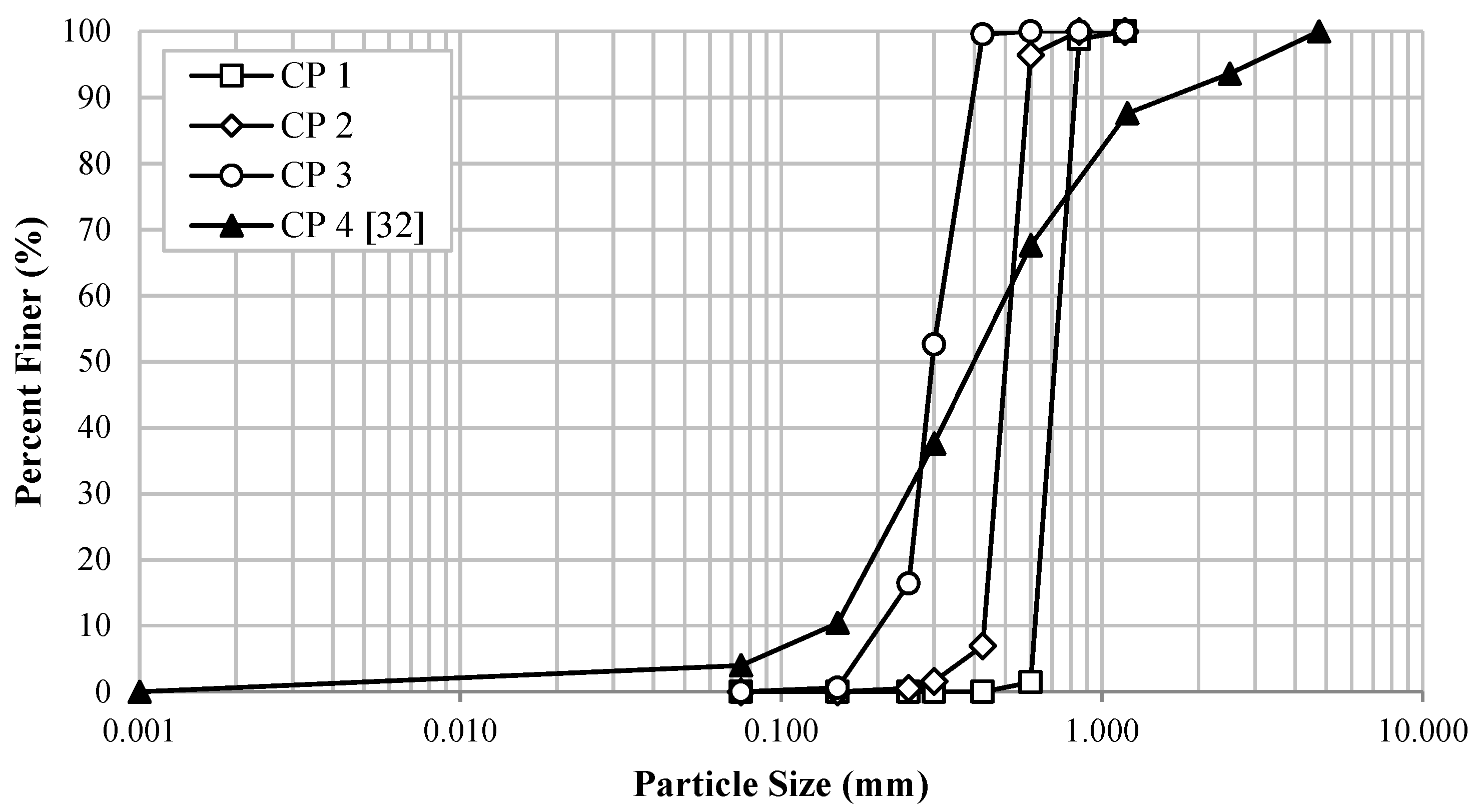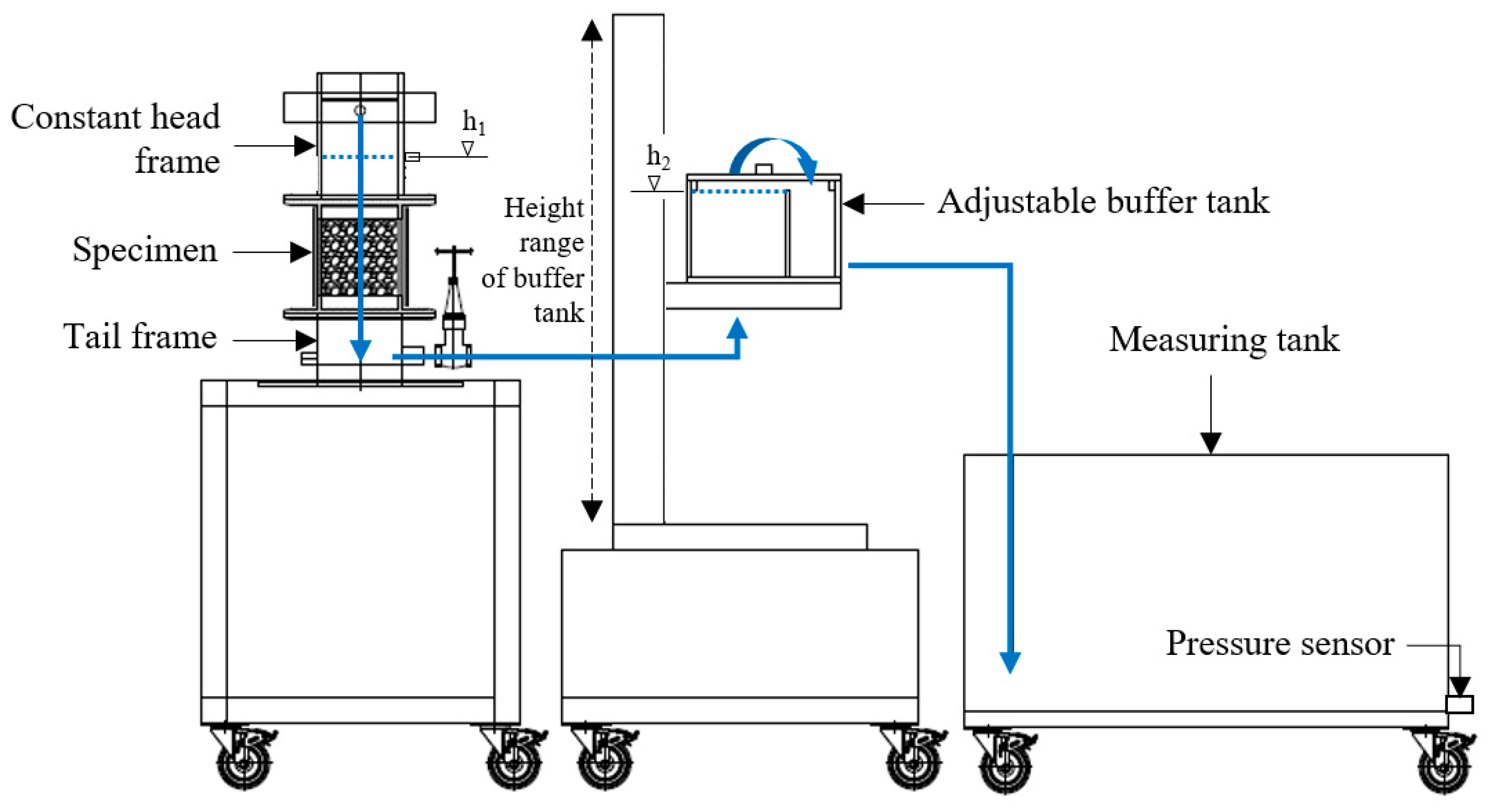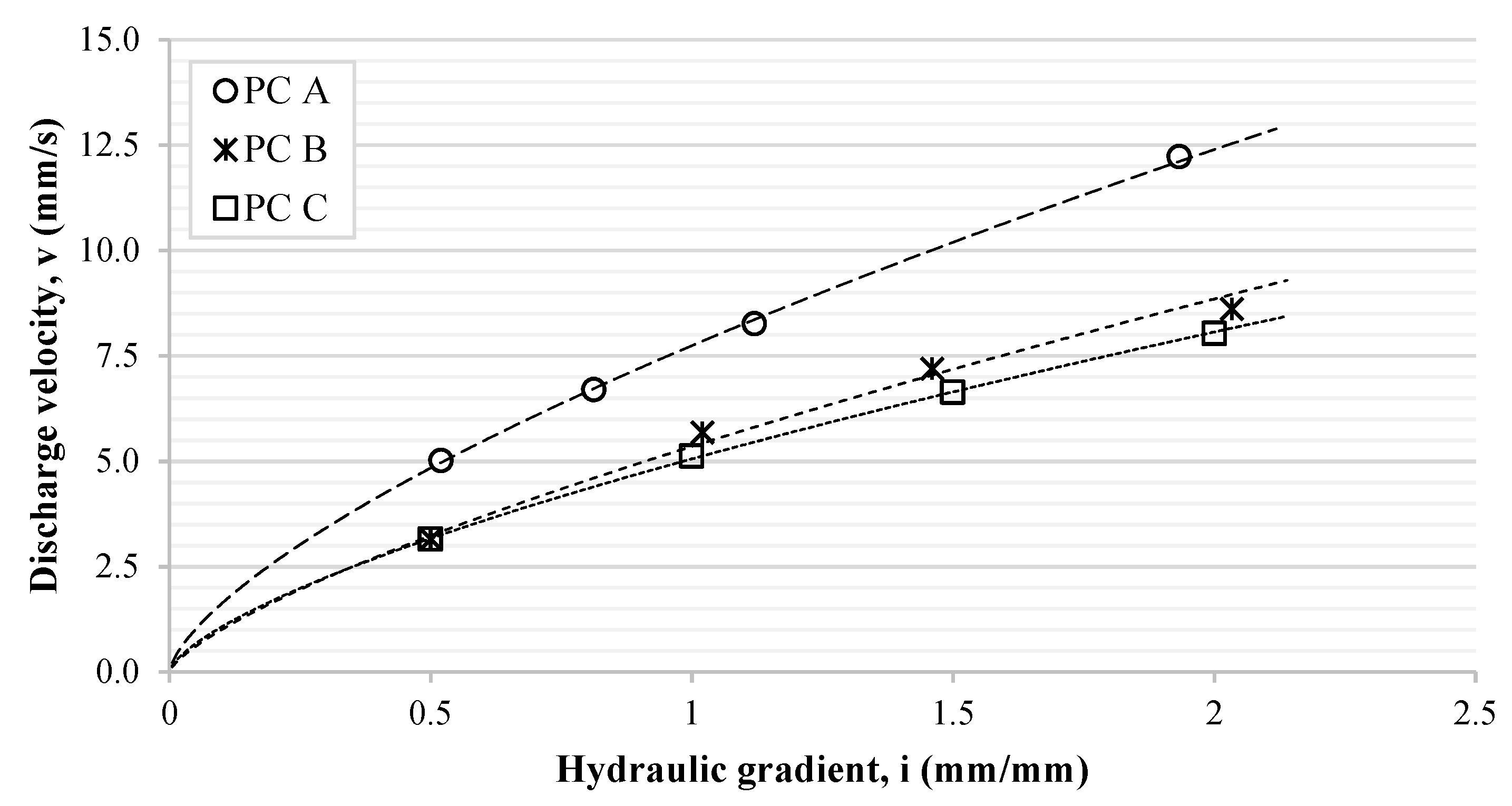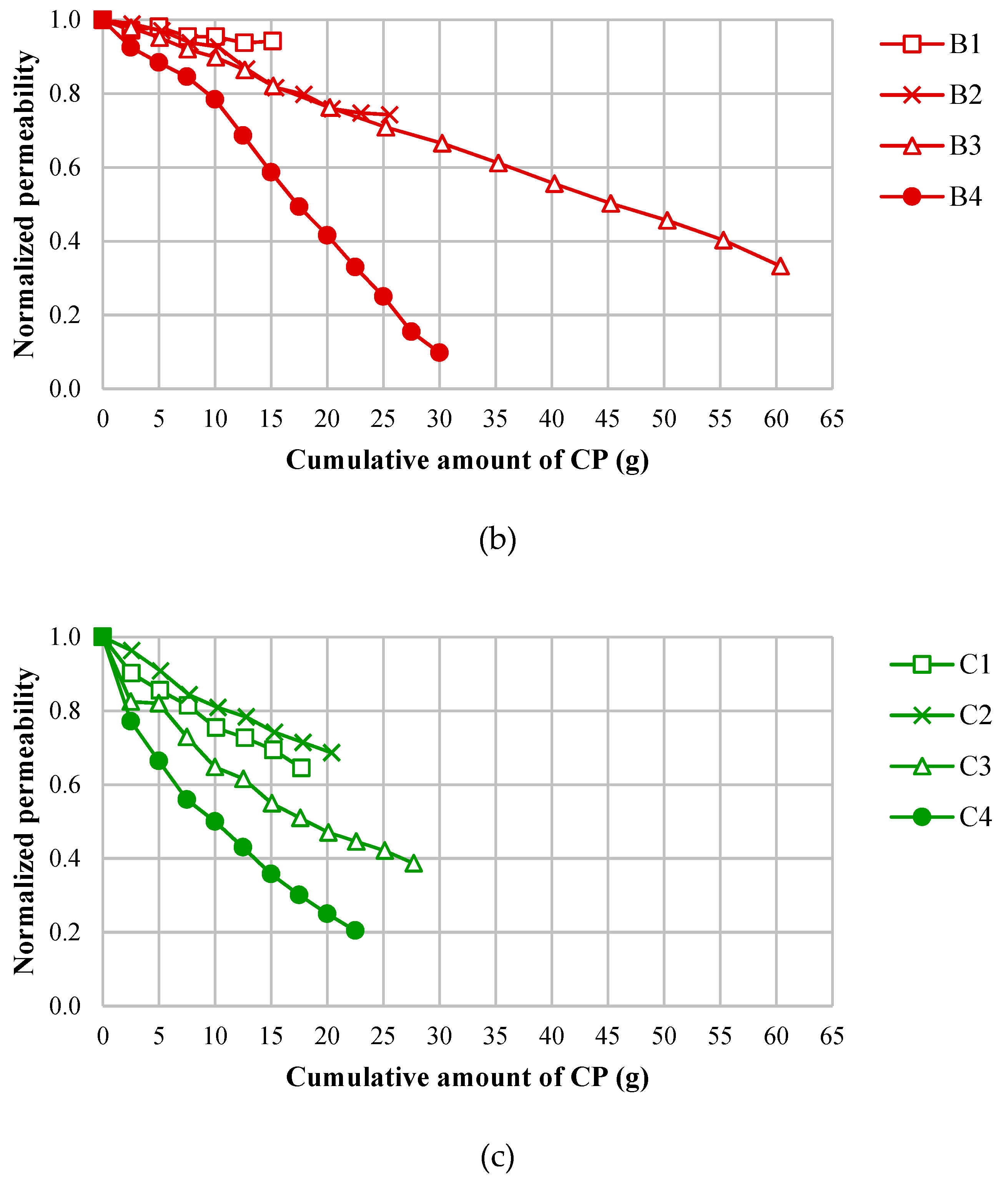Investigation of Particle-Related Clogging of Sustainable Concrete Pavements
Abstract
1. Introduction
2. Materials and Methods
2.1. Pervious Concrete Specimens
2.2. Clogging Particles (CP)
2.3. Measurement of Permeability
2.4. Experimental Program
3. Results
4. Conclusions
- Aggregate size influences the pore distribution of pervious concrete. Pervious concrete with higher NMAS contains bigger pores compared to pervious concrete with lower NMAS. Thus, an increase in NMAS results in an increase in representative pore size.
- Aside from porosity and NMAS, representative pore sizes have significant effects on the permeability of pervious concrete. The permeability was found to be 7.73, 5.43, and 5.03 mm/s for NMAS 10, 8, and 5 mm, respectively. It was found that the values of permeability, NMAS, and pore size are proportionally related given similar porosities.
- For aggregates with high porosity such as the pervious concrete specimens used in this study, Darcy’s law may no longer be used to determine the coefficient of permeability. A nonlinear relationship can be adopted to characterize the non-laminar flow found in highly permeable concrete mixes.
- With regard to the clogging of single-sized particles, it was observed that for certain aggregate sizes and corresponding pore sizes, some clogging particles resulted in significant pore reduction due to their size. The clogging particles that caused the highest permeability loss were found to have the smallest diameters that could allow particles to pass through the surface pores and be retained in the internal pores without being washed out.
- A minimum permeability loss of 80% was recorded among specimens permeated with graded clogging particles, whereas for specimens subjected to single-sized sand clogging, a maximum permeability reduction of 67% was recorded. Due to the presence of particles with a wide range of sizes, the degree of clogging of non-uniform sand was more severe compared to clogging of single-sized sands.
- When the pores of pervious concrete are fully covered by clogging particles, it appears that for some test cases, the permeability at terminal stage may be limited by the infiltration capacity of the clogging materials.
Author Contributions
Funding
Conflicts of Interest
References
- Booth, D.B. Urbanization and the natural drainage system-impacts, solutions, and prognoses. Northwest Environ. J. 1991, 7, 93–118. [Google Scholar]
- Chithra, S.V.; Nair, M.H.; Amarnath, A.; Anjana, N.S. Impacts of impervious surfaces on the environment. Int. J. Eng. Sci. Invent. 2015, 4, 27–31. [Google Scholar]
- Hollis, G.E. The effects of urbanization on floods of different recurrence intervals. Water Resour. Res. 1975, 11, 431–435. [Google Scholar] [CrossRef]
- Konrad, C.P.; Booth, D.B. Hydrologic Trends Associated with Urban Development for Selected Streams in the Puget Sound Basin, Western Washington; US Geological Survey: Tacoma, WA, USA, 2002.
- Konrad, C.P. Effects of Urban Development on Floods. U.S. Geological Survey Fact Sheet 076-03; 2003. Available online: https://pubs.usgs.gov/fs/fs07603/ (accessed on 11 December 2018).
- Marchioni, M.; Becciu, G. Permeable pavement used on sustainable drainage systems (SUDs): A synthetic review of recent literature. WIT Trans. Built Environ. 2014, 139, 183–194. [Google Scholar] [CrossRef]
- Ahiablame, L.M.; Engel, B.A.; Chaubey, I. Effectiveness of low impact development practices: Literature review and suggestions for future research. Water Air Soil Pollut. 2012, 223, 4253. [Google Scholar] [CrossRef]
- Dietz, M. Low impact development practices: A review of current research and recommendations for future directions. Water Air Soil Pollut. 2007, 186, 351–363. [Google Scholar] [CrossRef]
- Hunt, W.F.; Traver, R.G.; Davis, A.P.; Emerson, C.H.; Collins, K.A.; Stagge, J.H. Low impact development practices: Designing to infiltrate in urban environments. Eff. Urban. Groundwater 2010, 308–343. [Google Scholar] [CrossRef]
- Coffman, L.S.; France, R.L. Low-impact development: An alternative stormwater management technology. In Handbook of Water Sensitive Planning and Design; CRC Press Book: Boca Raton, FL, USA, 2002; pp. 97–123. [Google Scholar]
- Field, R.; Masters, H.; Singer, M. Status of porous pavement research. Water Res. 1982, 16, 849–858. [Google Scholar] [CrossRef]
- Lucke, T.; Beecham, S. Field investigation of clogging in a permeable pavement system. Build. Res. Inform. 2011, 39, 603–615. [Google Scholar] [CrossRef]
- Booth, D.; Leavitt, J. Field evaluation of permeable pavement systems for improved stormwater management. J. Am. Plan. Assoc. 1999, 65, 314–325. [Google Scholar] [CrossRef]
- Sañudo-Fontaneda, L.A.; Rodriguez-Hernandez, J.; Vega-Zamanillo, A.; Castro-Fresno, D. Laboratory analysis of the infiltration capacity of interlocking concrete block pavements in car parks. Water Sci. Technol. 2012, 67, 675–681. [Google Scholar] [CrossRef] [PubMed]
- Sartor, J.D.; Boyd, G.B. Water pollution aspects of street surface contaminants. Water Pollut. Control Fed. 1974, 46, 458–467. [Google Scholar]
- Brattebo, B.; Booth, D. Long-term stormwater quantity and quality performance of permeable pavement systems. Water Res. 2003, 37, 4369–4376. [Google Scholar] [CrossRef]
- Jiang, W.; Sha, A.; Xiao, J.; Li, Y.; Huang, Y. Experimental study on filtration effect and mechanism of pavement runoff in permeable asphalt pavement. Constr. Build. Mater. 2015, 100, 102–110. [Google Scholar] [CrossRef]
- Kadurupokune, N.; Jayasuriya, N. Pollutant load removal efficiency of pervious pavements: Is clogging an issue? Water Sci. Technol. 2009, 60, 1787–1794. [Google Scholar] [CrossRef]
- Van Duin, B.; Brown, C.; Chu, A.; Marsalek, J.; Valeo, C. Characterization of long-term solids removal and clogging processes in two types of permeable pavement under cold climate conditions. In Proceedings of the 11th International Conference on Urban Drainage, Edinburgh, UK, 31 August–5 September 2008. [Google Scholar]
- Pezzaniti, D.; Beecham, S.; Kandasamy, J. Influence of clogging on the effective life of permeable pavements. Proc. Inst. Civ. Eng. Water Manag. 2009, 162, 211–220. [Google Scholar] [CrossRef]
- Al-Rubaei, A.M.; Viklander, M.; Blecken, G.T. Long-term hydraulic performance of stormwater infiltration systems. Urban Water J. 2015, 12, 660–671. [Google Scholar] [CrossRef]
- Andres-Valeri, V.; Marchioni, M.; Sañudo-Fontaneda, L.; Giustozzi, F.; Becciu, G. Laboratory assessment of the infiltration capacity reduction in clogged porous mixture surfaces. Sustainability 2016, 8, 751. [Google Scholar] [CrossRef]
- Yong, C.F.; McCarthy, D.T.; Deletic, A. Predicting physical clogging of porous and permeable pavements. J. Hydrol. 2013, 481, 48–55. [Google Scholar] [CrossRef]
- Martin, W.D.; Putman, B.J.; Neptune, A.I. Influence of aggregate gradation on clogging characteristics of porous asphalt mixtures. J. Mater. Civ. Eng. 2014, 26. [Google Scholar] [CrossRef]
- Chen, J.; Li, H.; Huang, X.; Wu, J. Permeability loss of open-graded friction course mixtures due to deformation-related and particle-related clogging: Understanding from a laboratory investigation. J. Mater. Civ. Eng. 2015, 27. [Google Scholar] [CrossRef]
- Coughlin, J.P.; Campbell, C.D.; Mays, D.C. Infiltration and clogging by sand and clay in a pervious concrete pavement system. J. Hydrol. Eng. 2012, 17, 68–73. [Google Scholar] [CrossRef]
- Deo, O.; Sumanasooriya, M.; Neithalath, N. Permeability reduction in pervious concretes due to clogging: Experiments and modeling. J. Mater. Civ. Eng. 2010, 22. [Google Scholar] [CrossRef]
- Reddi, L.N.; Ming, X.; Hajra, M.G.; Lee, I.M. Permeability reduction of soil filters due to physical clogging. J. Geotech. Geoenviron. Eng. 2000, 126. [Google Scholar] [CrossRef]
- Coleri, E.; Kayhanian, M.; Harvey, J.T.; Yang, K.; Boone, J.M. Clogging evaluation of open graded friction course pavements tested under rainfall and heavy vehicle simulators. J. Environ. Manag. 2013, 129, 164–172. [Google Scholar] [CrossRef]
- Nielsen, C.B. Ravelling of Porous Pavements—Assessment of Test Section; Technical Note 48, Road Directorate; Danish Road Institute: Roskilde, Denmark, 2007. [Google Scholar]
- Liu, R.; Liu, H.; Sha, F.; Yang, H.; Zhang, Q.; Shi, S.; Zheng, Z. Investigation of the porosity distribution, permeability, and mechanical performance of pervious concretes. Processes 2018, 6, 78. [Google Scholar] [CrossRef]
- Seoul Metropolitan City. Standard on design, construction, and maintenance of permeable block pavements (Ver. 2.0), p.30. Available online: http://www.civiltech.co.kr/xe/66700 (accessed on 18 December 2018).
- Fwa, T.; Tan, S.; Guwe, Y. Laboratory evaluation of clogging potential of porous asphalt mixtures. Transp. Res. Board 1999, 1681, 43–49. [Google Scholar] [CrossRef]
- Huang, B.; Mohammad, L.; Raghavendra, A.; Abadie, C. Fundamentals of permeability in asphalt mixtures. J. Assoc. Asphalt Paving Technol. 1999, 68. [Google Scholar]
- Huang, B.; Wu, H.; Shu, X.; Burdette, E.G. Laboratory evaluation of permeability and strength of polymer-modified pervious concrete. Constr. Build. Mater. 2010, 24, 818–823. [Google Scholar] [CrossRef]
- Tan, S.; Fwa, T.; Guwe, V. Laboratory measurements and analysis of clogging mechanism of porous asphalt mixes. J. Test. Eval. 2000, 28, 207–216. [Google Scholar] [CrossRef]







| Specimen Designation | Percentage of Aggregates (%) | Nominal Max. Aggregate Size (NMAS) (mm) | Binder Content (%) | ||
|---|---|---|---|---|---|
| 8–10 mm | 5–8 mm | 3–5 mm | |||
| PC A | 100 | 0 | 0 | 10 | 5 |
| PC B | 0 | 100 | 0 | 8 | 5 |
| PC C | 0 | 0 | 100 | 5 | 5 |
| Specimen Designation | NMAS (mm) | Porosity (%) | Representative Pore Size (mm) |
|---|---|---|---|
| PC A | 10 | 30.7 | 2.847 |
| PC B | 8 | 31.0 | 2.425 |
| PC C | 5 | 34.3 | 1.768 |
| Clogging Particle | CP 1 | CP 2 | CP 3 | CP 4 |
|---|---|---|---|---|
| D10 (mm) | 0.64 | 0.44 | 0.23 | 0.15 |
| D30 (mm) | 0.69 | 0.48 | 0.27 | 0.25 |
| D60 (mm) | 0.74 | 0.52 | 0.31 | 0.5 |
| D50 (mm) | 0.7 | 0.5 | 0.3 | 0.4 |
| Cu | 1.16 | 1.18 | 1.35 | 3.33 |
| Cc | 1.01 | 1.01 | 1.02 | 0.83 |
| Experimental Code | Pervious Concrete Specimen | Clogging Particle |
|---|---|---|
| A1 | PC A | CP 1 |
| A2 | PC A | CP 2 |
| A3 | PC A | CP 3 |
| A4 | PC A | CP 4 |
| B1 | PC B | CP 1 |
| B2 | PC B | CP 2 |
| B3 | PC B | CP 3 |
| B4 | PC B | CP 4 |
| C1 | PC C | CP 1 |
| C2 | PC C | CP 2 |
| C3 | PC C | CP 3 |
| C4 | PC C | CP 4 |
| Specimen Designation | Initial Permeability, ko (mm/s) | Experimental Variable, n | Coefficient of Determination, R2 |
|---|---|---|---|
| PC A | 7.74 | 0.6786 | 0.9992 |
| PC B | 5.35 | 0.7259 | 0.9917 |
| PC C | 5.06 | 0.6737 | 0.9996 |
| Specimen Designation | Average Initial Permeability (mm/s) |
|---|---|
| PC A | 7.73 |
| PC B | 5.43 |
| PC C | 5.03 |
© 2018 by the authors. Licensee MDPI, Basel, Switzerland. This article is an open access article distributed under the terms and conditions of the Creative Commons Attribution (CC BY) license (http://creativecommons.org/licenses/by/4.0/).
Share and Cite
Marcaida, A.K.; Nguyen, T.H.; Ahn, J. Investigation of Particle-Related Clogging of Sustainable Concrete Pavements. Sustainability 2018, 10, 4845. https://doi.org/10.3390/su10124845
Marcaida AK, Nguyen TH, Ahn J. Investigation of Particle-Related Clogging of Sustainable Concrete Pavements. Sustainability. 2018; 10(12):4845. https://doi.org/10.3390/su10124845
Chicago/Turabian StyleMarcaida, Aryssa Kathreen, Tan Hung Nguyen, and Jaehun Ahn. 2018. "Investigation of Particle-Related Clogging of Sustainable Concrete Pavements" Sustainability 10, no. 12: 4845. https://doi.org/10.3390/su10124845
APA StyleMarcaida, A. K., Nguyen, T. H., & Ahn, J. (2018). Investigation of Particle-Related Clogging of Sustainable Concrete Pavements. Sustainability, 10(12), 4845. https://doi.org/10.3390/su10124845





